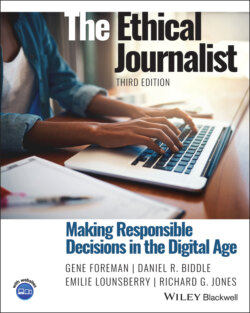Читать книгу The Ethical Journalist - Gene Foreman - Страница 67
Learning Goals
ОглавлениеThis chapter will help you understand:
• the widespread public hostility to the news media, which has been documented repeatedly in surveys;
• how journalists should respond to criticism; and
• the types of complaints that the public most often makes about the news media, and the lessons that can be learned from these complaints.
WHEN THE RED RIVER OVERFLOWED in the spring of 1997 and flooded Grand Forks and East Grand Forks, North Dakota, the Grand Forks Herald surmounted one obstacle after another to keep the community informed. The Herald’s printing plant was flooded and then destroyed by fire, inspiring the newspaper’s grim headline “Come hell and high water.” Still, the papers kept coming. The newsroom was moved to an elementary school, where the news was transmitted to the Pioneer Press in St. Paul, Minnesota. The papers were printed there and flown to Grand Forks for free distribution to the beleaguered North Dakotans.1
That was public service in journalism’s finest tradition.
But the goodwill soon dissipated in a torrent of criticism. What angered many of the Herald’s readers was its decision to disclose the identity of the donor who had given the towns $15 million and requested anonymity. From that gift, $2,000 was distributed to each of the 7,500 households hardest hit by the flood.
The disclosure was the result of a visit by Joan Kroc, widow of The McDonald’s founder, Ray Kroc. When Herald reporters learned that the donor was being given a tour of the flood area, they drove to the airport and established her identity from the tail markings on her private jet, from fuel receipts, and from interviews with airport employees.2 The story began: “Angel was in town Saturday night. So was Joan Kroc’s jet. This appears to be no coincidence.”3
“You owe the community and state an apology, as well as Mrs. Kroc,” one reader wrote in a letter to the editor. Another wrote, “If she was nice enough to give that much money, her wishes should have been respected.” A man who called in to a radio station’s talk show lamented: “The Herald has been wonderful through this whole thing, keeping the paper printed and distributing it for free. … This has ruined it all.”4 The newspaper’s own poll showed that 85 percent of respondents thought Kroc’s name should not have been published.5
The Herald’s decision to name the Angel is addressed here to illustrate the mercurial nature of the public’s attitudes toward the news media. Whether the Herald was right or wrong can be – and has been – debated in journalism circles. It should be noted, however, that the paper did not pursue the matter until the Angel toured the flood area. At that point, her identity became widely known in the community – but only among political and civic leaders. The average citizen was still in the dark.
The Herald explained in a front‐page statement: “[W]e believe printing the news is part of the bargain we have made with the community. We’d be breaking the bargain if we didn’t print the news.”6 Reflecting on that statement later, Herald editor Mike Jacobs told an audience of journalists: “News, we said, is timely information of general interest. The Angel’s identity was clearly news. Besides, we said, if she really wanted to remain anonymous, she should have driven into Grand Forks in a pickup truck. With a gun rack.”7
The controversy in Grand Forks did, in Jacobs’s words, “blow over.” But the newspaper’s precipitous fall from community hero to community villain demonstrates a paradox in American society: People do rely on the information that independent news media provide – and even praise it in times of crisis like September 11 and the flood in Grand Forks. Yet the people who value the information also like to complain, and they are apt to react in anger when they think the media’s agenda differs from their own.
The public’s relationship with the news media is, indeed, one of love and hate.
